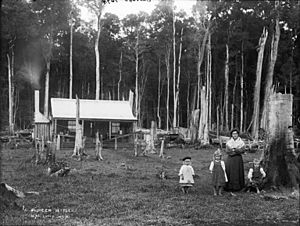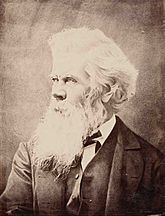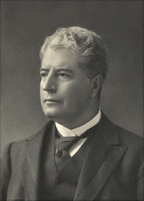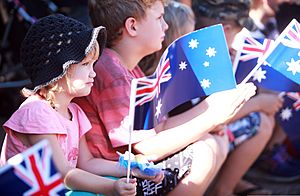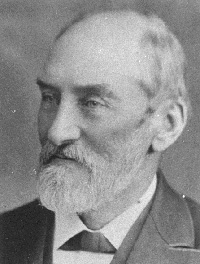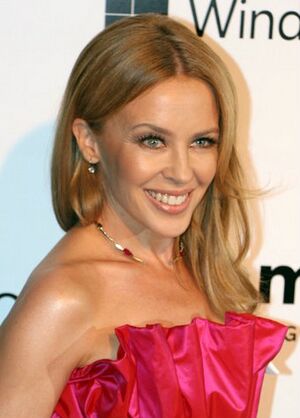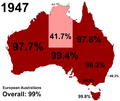European Australians facts for kids
| Total population | |
|---|---|
| 18,281,559–19,787,099 85–92% |
|
| Regions with significant populations | |
| All States and territories of Australia | |
| Languages | |
| Mainly English Italian • German • Greek • Dutch • Other European |
|
| Religion | |
| Christian (Anglican and Roman Catholic), Judaism, and others | |
| Related ethnic groups | |
| European diaspora |
European Australians are people living in Australia whose families originally came from Europe. They are also sometimes called White Australians.
Since the early 1800s, most people in Australia have been of European background. Many European Australians have ancestors from the British Isles. This includes people from England, Ireland, Scotland, Wales, or Cornwall. In 2010, about 74% of Australians were thought to have Anglo-Celtic (British or Irish) family roots.
Other large groups of European Australians have ancestors from Italy, Germany, Greece, Dutch, New Zealand (European New Zealanders), Poland, Malta, and Croatia. Today, people with British and other European backgrounds make up about 85–92% of Australia's total population.
Historically, European immigrants had a big impact on Australia's history and society. This led to Australia being seen as a European country.
Contents
History of Europeans in Australia
First European Explorers Arrive
The first European sailors arrived in Australian waters around 1606. They wrote about the land, which was then called Terra Australis Incognita (meaning "unknown southern land"). The first ship to map part of the Australian coast and meet Aboriginal people was the Duyfken. It was led by a Dutch captain named Willem Janszoon.
Between 1606 and 1770, about 54 European ships visited Australia. Many were trading ships from the Dutch East Indies Company. Famous explorers like Abel Tasman charted parts of Australia's north, west, and south coasts. This land was then known as New Holland.
In 1770, British Lieutenant James Cook mapped Australia's east coast in his ship, the HM Barque Endeavour. On August 22, 1770, Cook claimed the east coast for King George III. He named this area 'New South Wales'. Later, English sailors Bass and Flinders, and French sailor Baudin, mapped the Australian coastline in detail. Flinders published a nearly complete map in 1814.
Many places in Australia are named after these early European explorers. Examples include the Torres Strait, Arnhem Land, Tasmania, and La Perouse.
The First European Settlements
The British Crown Colony of New South Wales began on January 26, 1788. This was when Captain Arthur Phillip set up a settlement at Sydney Cove. This date is now Australia Day, Australia's national holiday. At first, New South Wales also included the islands of New Zealand. Van Diemen's Land, now called Tasmania, was settled in 1803.
The first European Australians came from the United Kingdom and Ireland. The southeast of Australia was the first area where Europeans settled in 1788.
Other British settlements were started around the continent. Some of these were not successful. In 1824, a prison colony was set up near the Brisbane River. This became the basis for the later colony of Queensland. In 1826, a British military camp was started in Western Australia at King George Sound. This was to stop the French from colonizing the area. This camp later became the town of Albany. In 1829, the Swan River Colony and its capital, Perth, were founded on the west coast. Western Australia first started as a free colony. Later, it accepted British prisoners because it needed more workers.
In 1835, the British government made a rule called the Proclamation of Governor Bourke. This rule said that the land in Australia belonged to no one before the British claimed it. This idea is called terra nullius. It meant that anyone living on the land without government permission was considered an illegal trespasser.
New colonies were created from parts of New South Wales. These included South Australia in 1836, New Zealand in 1840, Victoria in 1851, and Queensland in 1859. The Northern Territory became part of South Australia in 1863. The practice of sending prisoners to Australia ended between 1840 and 1868.
Large areas of land were cleared for farming and other uses. This greatly affected Indigenous Australians. It reduced their food, shelter, and other important resources. Many Indigenous people died from new diseases and a lack of resources. There were also many conflicts between Indigenous people and settlers from 1788 to the 1930s. These fights led to the deaths of at least 20,000 Indigenous people and about 2,000 to 2,500 Europeans.
The European population grew quickly. In 1800, Europeans made up 0.3% of the continent's population. By 1850, this had grown to 58.6%. In 1868, there were 1,539,552 European Australians.
In the 1800s, Irish people made up about 25% of the European Australian population. Germans were the largest non-British group for most of the 19th century.
By 1976, the top six groups of people born overseas were from European countries. They made up 81% of all foreign-born people. By 1996, these top six groups were only 53% of the total foreign-born population. People from the United Kingdom and Ireland are still the largest group. However, their share of the total overseas-born population has decreased. It fell from 41% in 1976 to 29% in 1996.
After World War II
After World War II, the Australian government started a huge program to bring in more European immigrants. After almost being invaded by Japan, Australia felt it needed to "populate or perish" (meaning, get more people or risk being taken over). Before the war, Australia mostly saw itself as British and Irish. But after the war, it looked to the United States as an example of a successful country built by people from many European backgrounds.
This new immigration brought people from the United Kingdom. It also brought, for the first time, large numbers of people from southern and central Europe. Australia's economy was doing very well, unlike war-torn Europe. New immigrants found jobs in government projects, like the Snowy Mountains Scheme. Two million immigrants arrived between 1948 and 1975.
In 1987, most European Australians were descendants of Anglo-Irish-Scots who arrived after 1850. Others were descendants of Greeks, Italians, Hungarians, Balts, Poles, and Germans who came after 1945.
Number of European Australians
Australia's census has changed how it asks about people's backgrounds over time. From 1911 to 1966, it asked about race. In 1971 and 1976, it asked about racial origin. Since 1981, it asks about ethnic origin.
In the 2011 Census, Australians reported about 300 different ancestries. The most common were British (45%) and Australian (33%). Six of the top ten ancestries showed Australia's European heritage. These included Irish (9.7%), Italian (4.3%), German (4.2%), Greek (1.8%), and Dutch (1.6%).
Since 1976, the census does not ask about racial background. So, it is not clear exactly how many Australians are descendants of Europeans. Estimates range from 85% to 92%. In 2000, it was thought that about 25% of European Australians had Irish ancestors.
Political Involvement
Colonial Period and Early Leaders
The first European settlers in Australia were mostly from England. Their descendants often held powerful positions. They helped create laws because many had been involved in government in England. The six separate British self-governing colonies in Australia were Queensland, New South Wales, Victoria, Tasmania, South Australia, and Western Australia. These colonies later agreed to join together to form the Commonwealth of Australia. This created a system of federal government.
Founding Fathers of Australia
Many of Australia's "Founding Fathers" had British backgrounds, especially English. Some important figures include:
- Sir Henry Parkes was from Coventry, England. He is often called the "Father of Federation" in Australia. He strongly supported uniting the Australian territories in the late 1800s. Sadly, he died before Australia became a federation.
- Captain James Cook was the Englishman who claimed Australia for Britain.
- Captain Arthur Phillip (Englishman) was the first governor of New South Wales. He founded the first colony.
- Sir Edmund Barton (whose parents were English) was Australia's first Prime Minister.
- Scotsman Lachlan Macquarie greatly influenced New South Wales. He helped it change from a prison colony to a free settlement. He played a big role in shaping Australian society in the early 1800s. An inscription on his tomb in Scotland calls him "The Father of Australia."
Culture
European-Australian culture is the main culture of Australia. It is mostly a Western culture. However, it is also shaped by Australia's unique geography. The cultures of Aboriginal and Torres Strait Islander people also have an impact. The British colonisation of Australia began in 1788. After that, many different groups of people from around the world moved to Australia, adding to its culture.
Since English people were always the largest group of settlers, their culture had the biggest influence. This is why English is the main language. Other influences include common law, the Westminster system of government, and Christianity (especially Anglicanism) which was once the main religion. Popular sports like cricket and rugby also come from this heritage. Australian culture has changed a lot since British settlement.
Several states and territories started as prison colonies. The first British prisoners arrived at Sydney Cove in 1788. Stories of outlaws like the bushranger Ned Kelly are still popular in Australian music, movies, and books. The gold rushes from the 1850s brought wealth and new social issues. For example, miners rebelled in the Eureka Stockade. The colonies set up elected parliaments and gave rights to workers and women earlier than many other Western nations.
Language in Australia
Australian English is a main type of the English language. It is spoken all over Australia. Even though English is not officially named in the Constitution, Australian English is the country's main language. It is the first language for most Australians.
Australian English started to become different from British English after the colony of New South Wales was founded in 1788. By 1820, it was clearly its own type of English. It developed from the mixing of early settlers who came from many different parts of the British Isles. These settlers spoke dialects that were easy for each other to understand. This new Australian English quickly became a unique way of speaking.
The first children born in the colony of New South Wales created this new dialect. They heard many different ways of speaking from all over the British Isles, especially from Ireland and South East England. These Australian-born children made a new dialect that became the language of the nation. Even when new settlers arrived, this new dialect was strong enough to influence other ways of speaking.
About a quarter of the early prisoners were Irish. Many of them spoke little or no English. There were also many prisoners from non-English speaking parts of Britain, like the Scottish Highlands and Wales.
The most common European languages spoken in Australia, other than English, are Italian, Greek, and German.
Australian Music and Songs
Australian patriotic songs are an important part of the culture:
- "Advance Australia Fair" is Australia's national anthem. A Scottish-born composer named Peter Dodds McCormick created the song. It was first performed in 1878 and was sung as a patriotic song. It replaced "God Save the Queen". It became the official anthem in 1984, after Australians voted for it in 1977.
- "Waltzing Matilda" is Australia's most famous bush ballad. It is often called the country's "unofficial national anthem." The Scottish-Australian poet Banjo Paterson wrote the words in January 1895. He was staying at Dagworth Station in Queensland. The words were written to a tune played by Christina Macpherson, a family member at the station.
- "The Song of Australia" was written by an English-born poet named Caroline Carleton in 1859. The music was composed by the German-born Carl Linger.
Entertainment and Famous Australians
Kylie Minogue is a very famous Australian singer. She is known as the "Princess of Pop" and "Goddess of Pop." She has sold more records than any other Australian artist. Kylie was born in Melbourne, Australia, on May 28, 1968. Her father is a fifth-generation Australian with Irish ancestors. Her mother came from Maesteg, Wales.
Architecture in Australia
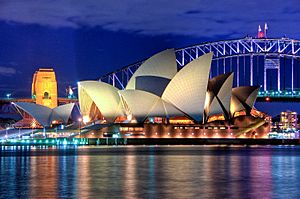
The Sydney Opera House is one of Australia's most famous buildings. Queen Elizabeth II officially opened it on October 20, 1973. The design was chosen in 1957 from an international competition. Danish architect Jørn Utzon won the competition. The government of New South Wales decided to build Utzon's design in 1958. Utzon led the construction. The project faced problems with costs and delays, and the architect eventually left.
Australia has three buildings or sites listed on UNESCO's World Heritage list. These are the Australian Convict Sites (including places like Hyde Park Barracks and Port Arthur), the Sydney Opera House, and the Royal Exhibition Building in Melbourne. Other well-known Australian structures include the Harbour Bridge in Sydney and Parliament House, Canberra.
Important architects who worked in Australia include Governor Lachlan Macquarie's architect, Francis Greenway. Others are William Wardell, Walter Burley Griffin (who designed Canberra's layout), and Harry Seidler. Jørn Utzon designed the Sydney Opera House. The National Trust of Australia is an organization that helps protect Australia's historic buildings.
Images for kids
See also
 In Spanish: Inmigración europea en Australia para niños
In Spanish: Inmigración europea en Australia para niños


